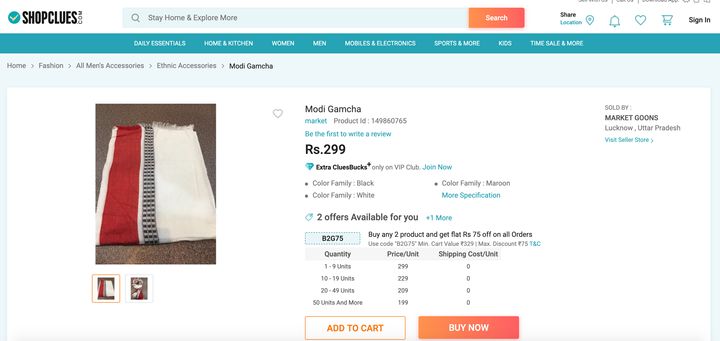
On April 14, when Prime Minister Narendra Modi addressed the country during the national lockdown, he wore the Leirum Phee, Manipur’s traditional cloth, as a mask. Since then, the scarf has gained a wave of popularity that, news reports say, led to Barabanki, a town in Uttar Pradesh, mass-manufacturing what has been labelled as a ‘Modi gamcha’. These reports about the misappropriation of Manipur’s historical and cultural artefact have led to a wave of discontent within the state.
The Directorate of Handloom and Textiles, Manipur, has written a letter to the Union textile ministry, requesting its intervention to halt mass production of the ‘Modi Gamcha’ in UP. The directorate also said in the letter that it has begun the process to acquire a Geographical Identification (GI) tag for ‘phee’ (which means ‘cloth’ in Meitei).

The Leirum Phee is Manipur’s proud contribution to the plethora of handloom textiles of India. Skilled weavers use hand-weaving technology to make the scarf, whose production involves intensive manual effort. It is also of historical and cultural significance to the state, especially the Meitei and Tangkhul communities of Manipur.
According to lore, centuries ago, the Leirum Phee was gifted by the Tangkhuls to the Meiteis as a tribute establishing a healthy relationship between the hill and the valley communities. Since then, it has been an integral element of the Meitei marriage—it is an indispensable component of the “Pham Konba”, the blessing ritual of a Meitei wedding where the family of the bride gifts her “Ningol Gi Awunpot” that includes bedding for her nuptial bed. Many also believe that the motifs signify guardianship.
In 1078-1112 AD present-day Manipur, under the reign of King Loyumba, 32 “yumnak” (surnames) were assigned to weave handloom textiles bearing unique motifs. Of the 32 “yumnak”, the 11th in order was the Shal Chiram “yumnak”, who were assigned to weave the Leirum Phee, writes author, anthropologist and cultural activist Mutua Bahadur. This was the first recorded history of the Leirum Phee, he added in an article written in Sanaleibak.
The Leirum Phee scarf is also proudly presented to dignitaries visiting Manipur. Further away from home, the Leirum Phee motifs are used by fashion designers from the state to represent their culture on national and international ramps. On auspicious occasions, most Meitei men drape a Leirum Phee “leng-yan” (shawl for men) over one side of their shoulder.
While in a country like India, different cultures do borrow from and influence each other, cultural misappropriation is not the same as mutual cultural exchange, because it is shaped by power dynamics. It is an instance where a member of a dominant culture (which often has a record of oppressing other cultures) takes something from the culture of a minority group without authorisation, Jessica Metcalfe wrote in a 2012 article for The Guardian. In this case, the identity of an element of importance and reverence for a minority culture is being erased of its origin, renamed, repackaged and sold for profit. That is cultural misappropriation.
The Northeast region of India is like a magician on commission. When mainstream need arises, its culture is suddenly pulled out of a hat to leave you awestruck by its glory. When the show is over, the audience packs up and leaves, and soon forgets about its existence. Rather, they are made to forget about it. NCERT history books don’t dedicate much space to the North East; representation in Parliament is shamefully meagre, racial discrimination against people from the Northeast is rampant, and the region now suffers from rapid cultural erosion. The Northeastern states have had to struggle harder than other states to remain relevant for national governance and attention. The fight for significance is harder for marginalised states when the voice of the Northeast has often been sidelined to make way for the mainland.
How is it that one shows love for someone’s culture but remains prejudiced against the people? It is less a question to the impoverished factory workers of Barabanki, and more for the nation as a whole.
To ignore the hard work and plight of the weaving and artisanal community of Manipur would be a great injustice. Wahengbam Nilamani Singh, Former Managing Director, Manipur Handloom and Handicrafts Development Corporation, told this writer that this craftsmanship is often considered an heirloom passed down from generations. Despite hardships, he says, the community has held their head high and forged their way through.
The Leirum Phee is made only in Manipur. Over the years, the weaving community has declined in numbers. Many have left the profession in search of more financially sustainable means of living. Of the limited bulk export requests for Manipur’s handloom textiles, not all can be met as most weavers produce handloom products in limited numbers using manually powered looms. Singh said that the weavers of Manipur need encouragement from the government in the form of adequate resources, incentives, building of an export customer base, popularisation of the art, specialised training of weavers by handloom experts and most importantly, the provision of dedicated working space for weavers that can guarantee an adequate supply of the handloom product to meet international demands. The weaving community needs to be empowered for them to have the freedom to improve their livelihood and to chart new paths for the future of handlooms and handicrafts of Manipur, he added.
As citizens, we must not let the great phrase that defines this nation, “Unity in Diversity”, succumb to nothing but a marketing gimmick. Diversity must be upheld, but respect for indigenous cultures cannot be forsaken.
The author is a social media strategist who is currently a freelance consultant for the Indian Youth Congress.